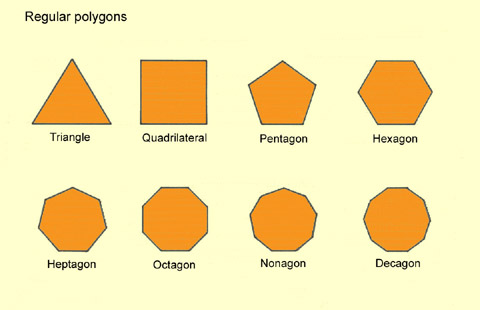Lesson overview
Outcomes
- Students are able to draw and name various polygons.
- Students are able to recognise and understand some words in Greek and reproduce these words to convey simple information.
Introduction
Students often find technical terms unneccessarily difficult to remember. Often simplified terms are substituted by teachers to assist students to understand concepts. In this activity, Languages Other Than English (LOTEs) are used as a means of assisting students to recognise the meaning of some common terms used in geometry. At the same time, the contributions of diverse cultures to the development of geometric concepts is emphasised.
Worksheets to download
Activities
1. Polygons and the Greek language
- Introduce the concept of polygons to students explaining that a polygon is a closed shape with three or more angles or sides. Explain that polygons are named according to the number of angles (or sides) that they have and that these names have come historically from the Greek language. In Greek, the name polygon means many corners or angles – poly meaning much or many and gonia meaning corner or angle. For example, pentagons have five angles – pente meaning five and octagons have eight angles – octo.
- Using the worksheet, Counting in Greek, teach the class how to count to 10 in Greek. Students will need to practise and repeat the numbers until they feel confident that they can remember most of the numbers. You may invite a Greek-speaking languages teacher, community member or student to assist.
- Using the worksheet, Drawing polygons, ask students to draw a number of different polygons (regular or irregular) and then in pairs guess the names of each of the polygons based on the Greek numbers that they have learnt.
- On the board or on butchers paper, record students’ guesses for each of the shapes. Then, provide the correct terms for each of the shapes.
- Follow up: Ask students to draw (or otherwise create) equal-sided (regular) polygons from 3-10 sided and label them with the correct terminology.
Additional strategies
- Using the above model, teach students how to count in Greek beyond 10 and ask them to name polygons of more than 10 sides. Students may need to research the official names of polygons of more than 10 sides and also numbers in Greek beyond 10.
- Introduce other Languages Other Than English (LOTEs) to help students understand other terms used in geometry. For example, Latin-based LOTEs for quadrilateral, equilateral etc. The linguistic skills of the class may be drawn on to assist.
Date: 11 December 2002

